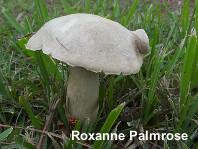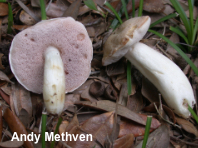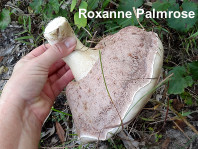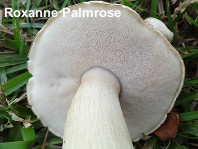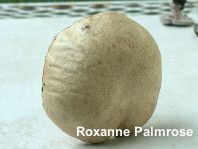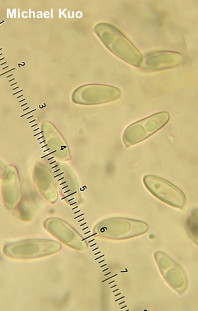| Major Groups > Boletes > Tylopilus > Tylopilus rhoadsiae |

|
Tylopilus rhoadsiae [ Basidiomycota > Boletales > Boletaceae > Tylopilus . . . ] by Michael Kuo Look for Tylopilus rhoadsiae in the southeastern United States, especially along the Gulf Coast, under pines. Like most other species of Tylopilus it features a pink spore print and a pink mature pore surface—but unlike most of the other species in the genus, its cap and stem are often nearly white. The reticulation over the top part of the stem, the unstaining flesh, and the bitter taste round out the distinctive features for the species. In the northern Midwest and the northeastern states, Tylopilus intermedius is a similar species; there may be some overlap in the two species' ranges in the southern Appalachians. However, Tylopilus intermedius is more likely to be associated with oaks, and features a dirty-looking, brownish-stained stem, along with a cap surface that features an exceptionally thin "skin," prone to wrinkling and flaking away with old age. Tylopilus peralbidus is another pale species from the southeast, separated by its preference for hardwoods, staining flesh, and smaller spores. Thanks to Roxanne Palmrose for collecting, documenting, and preserving Tylopilus rhoadsiae for study; her collection is deposited in The Herbarium of Michael Kuo—and thanks to Andy Methven for facilitating study of Tylopilus rhoadsiae. Description: Ecology: Primarily mycorrhizal with pines, but also reported under oaks; growing alone, scattered, or gregariously; summer, fall, or over winter; distributed in the southeastern United States, especially along the Gulf Coast. The illustrated and described collections are from Florida and Georgia. Cap: 4–20 cm; convex when young, becoming broadly convex or nearly flat in age; dry; bald or very finely velvety; whitish to very pale grayish or pale tan; the margin overhanging the pore surface by 1 mm or so. Pore Surface: Depressed around the stem; white at first, becoming pinkish and, eventually, grayish pink; not bruising; pores circular to angular, 1–3 per mm; tubes to 15 mm deep. Stem: 6–10 cm long; 1–2.5 cm thick; more or less equal, or with a slightly enlarged base; whitish, becoming very pale brownish; reticulate over the upper one-third or so with a fine, brown reticulum; basal mycelium white. Flesh: White; not staining when sliced. Odor and Taste: Odor not distinctive; taste bitter. Microscopic Features: Spores 10–14 x 3.5–5 µm; fusiform; smooth; hyaline in KOH. Basidia 4-sterigmate. Hymenial cystidia 35–50 x 7.5–12.5 µm; lageniform to narrowly fusiform; thin-walled; smooth; hyaline to golden in KOH. Pileipellis a poorly defined, collapsing trichoderm; hyaline to brownish yellow in KOH; elements 5–12.5 µm wide. REFERENCES: (Murrill, 1940) Murrill 1944. (Singer, 1947; Snell & Dick, 1970; Smith, Smith & Weber, 1981; Both, 1983; Wolfe, 1983; Weber & Smith, 1985; Bessette, Roody & Bessette, 2000; Binion et al., 2008.) Herb. Kuo 12101501, 09192001 (portion of ASM 12466). This site contains no information about the edibility or toxicity of mushrooms. |
© MushroomExpert.Com |
|
Cite this page as: Kuo, M. (2020, October). Tylopilus rhoadsiae. Retrieved from the MushroomExpert.Com Web site: http://www.mushroomexpert.com/tylopilus_rhoadsiae.html |
